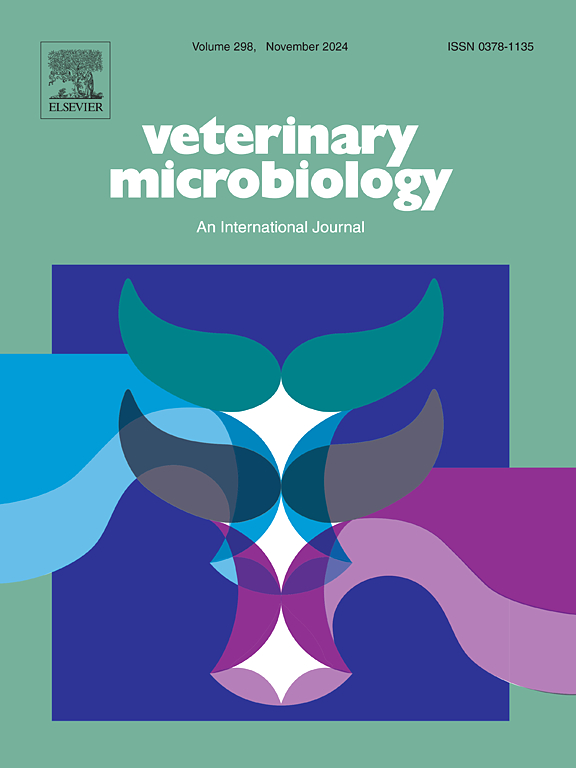Prevalence and infection characteristics of common pathogens associated with calf diarrhoea in Danish dairy calves
IF 2.4
2区 农林科学
Q3 MICROBIOLOGY
引用次数: 0
Abstract
Diarrhoea in calves is one of the most common disease manifestations, particularly within the first weeks of life. In the present study, 392 diarrhetic faecal samples from calves 0–28 days old were obtained from Danish dairy farms through routine veterinary diagnostics. Bovine pathogens (Clostridium perfringens type A, B and C, Salmonella enterica serovar Dublin, coronavirus, rotavirus, Cryptosporidium parvum, Coccidia (Eimeria) and Escherichia coli F5) were detected and quantified by qPCR (Enterit4calves assay). In addition, samples were cultured to semi-quantify the level of E. coli. Samples were primarily obtained from calves within the first two weeks (∼90 % of the samples), reflecting this critical period for diarrhoea development. Overall, C. perfringens type A, rotavirus and C. parvum were the most prevalent pathogens, detected in 28–39 % of the samples, while coronavirus and E. coli F5 were found in less than five percent of the samples. The remaining pathogens were not detected by qPCR in any of the samples. Culturing demonstrated moderate to massive growth of E. coli in 75 % of the samples, independent of the age of the sampled calves. For all qPCR detected pathogens, except for coronavirus and E. coli F5, dual-infection with the presence of two pathogenic agents in the sample, was the most common infection type. In samples with more than one pathogen, the quantity of each pathogen according to Ct-value was not significantly different from quantity of the same pathogen in samples where it was the only pathogen. The importance of the high prevalence of non-F5 E. coli needs to be further clarified, in particular for the types of E. coli found in moderate to massive growth in fecal samples negative for all qPCR included pathogens.
丹麦奶牛犊牛腹泻相关常见病原体的流行和感染特征
犊牛腹泻是最常见的疾病表现之一,特别是在出生后的最初几周内。在本研究中,通过常规兽医诊断,从丹麦奶牛场获得了392例0-28日龄犊牛腹泻粪便样本。采用qPCR (enterit4犊牛法)对A、B、C型产气荚膜梭菌、都柏林型肠炎沙门氏菌、冠状病毒、轮状病毒、细小隐孢子虫、球虫(艾美耳球虫)和大肠杆菌F5等牛病原菌进行定量检测。此外,对样品进行培养,以半量化大肠杆菌的水平。样本主要来自头两周内的犊牛(约90% %),反映了这一腹泻发展的关键时期。总体而言,产气荚膜荚膜原A型、轮状病毒和细小荚膜原是最常见的病原体,在28% - 39% 的样本中检测到,而冠状病毒和大肠杆菌F5在不到5%的样本中检测到。在所有样品中均未检测到剩余的病原体。培养表明大肠杆菌在75% %的样品中有中等到大量的生长,与犊牛的年龄无关。除冠状病毒和大肠杆菌F5外,在qPCR检测到的所有病原体中,双重感染是最常见的感染类型。在有一种以上病原体的样品中,每种病原体的ct值与唯一病原体的样品中同一病原体的数量没有显著差异。非f5型大肠杆菌的高流行率的重要性需要进一步澄清,特别是在所有qPCR包括的病原体均阴性的粪便样本中发现的中等至大量生长的大肠杆菌类型。
本文章由计算机程序翻译,如有差异,请以英文原文为准。
求助全文
约1分钟内获得全文
求助全文
来源期刊

Veterinary microbiology
农林科学-兽医学
CiteScore
5.90
自引率
6.10%
发文量
221
审稿时长
52 days
期刊介绍:
Veterinary Microbiology is concerned with microbial (bacterial, fungal, viral) diseases of domesticated vertebrate animals (livestock, companion animals, fur-bearing animals, game, poultry, fish) that supply food, other useful products or companionship. In addition, Microbial diseases of wild animals living in captivity, or as members of the feral fauna will also be considered if the infections are of interest because of their interrelation with humans (zoonoses) and/or domestic animals. Studies of antimicrobial resistance are also included, provided that the results represent a substantial advance in knowledge. Authors are strongly encouraged to read - prior to submission - the Editorials (''Scope or cope'' and ''Scope or cope II'') published previously in the journal. The Editors reserve the right to suggest submission to another journal for those papers which they feel would be more appropriate for consideration by that journal.
Original research papers of high quality and novelty on aspects of control, host response, molecular biology, pathogenesis, prevention, and treatment of microbial diseases of animals are published. Papers dealing primarily with immunology, epidemiology, molecular biology and antiviral or microbial agents will only be considered if they demonstrate a clear impact on a disease. Papers focusing solely on diagnostic techniques (such as another PCR protocol or ELISA) will not be published - focus should be on a microorganism and not on a particular technique. Papers only reporting microbial sequences, transcriptomics data, or proteomics data will not be considered unless the results represent a substantial advance in knowledge.
Drug trial papers will be considered if they have general application or significance. Papers on the identification of microorganisms will also be considered, but detailed taxonomic studies do not fall within the scope of the journal. Case reports will not be published, unless they have general application or contain novel aspects. Papers of geographically limited interest, which repeat what had been established elsewhere will not be considered. The readership of the journal is global.
 求助内容:
求助内容: 应助结果提醒方式:
应助结果提醒方式:


